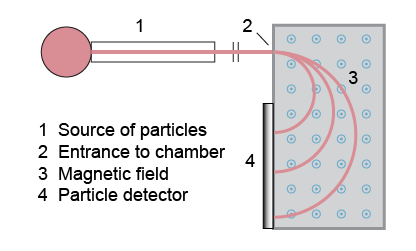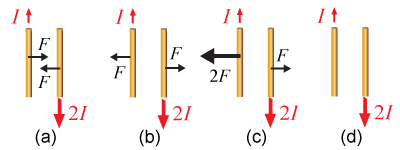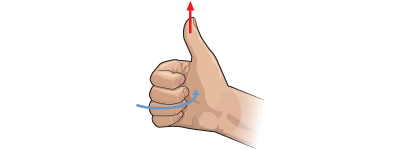
- The device shown fires charged particles into a chamber that has a uniform magnetic field. There, the particles are deflected by magnetic forces. The magnetic field comes toward you at right angles to the plane of the page. What is the sign of the charge for the particles whose paths are shown here?
- positive only
- negative only
- positive and negative
- There is not enough information provided.

- Two equally long parallel wires carry currents that are flowing in opposite directions, with Wire 2 carrying twice as much current as Wire 1. Which of the following statements can correctly describe the forces that each wire exerts upon the other?
- Wires 1 and 2 attract each other with equal strength.
- Wires 1 and 2 repel each other with equal strength.
- Wire 1 repels Wire 2 with a force F, and Wire 2 repels Wire 1 with twice as much force.
- Neither wire attracts or repels the other.
- One of the following wire loops would not induce any electric current. Which is it?
- A wire loop at rest in a constant magnetic field.
- A wire loop at rest in a changing magnetic field.
- A wire loop that rotates around an axis at right angles to a constant magnetic field.
- A wire loop with a permanent magnet continuously moving into and out of it.
| | 
- The right-hand rule is shown for the magnetic field produced by the current in a straight wire. Which of the following statements best expresses this rule?
- If you point your fingers in the direction of the magnetic field, then your thumb will indicate the direction of the current.
- If you point your thumb in the direction of the current, then your curled fingers show the direction of the magnetic field.
- If you curl your fingers in the direction of the current, then your thumb will point in the direction of the magnetic field.
- If you move your thumb in the direction of the magnetic field, then your fingers will point in the direction of the current.
- A motor spins because the magnetic field of an electromagnet in the motor changes direction, alternately attracting and repelling a permanent magnet. What causes the magnetic field to change direction?
- The current flow increases and decreases.
- The distance between magnets changes.
- The current direction is reversed.
- The current is switched on and off.
- One part of an iron core is wound with three loops of wire. Another part of the same iron core is wound with a six-loop coil. Electric current is passed through the first coil and a light bulb, motor, or other load is attached to the second. What type of device is this?
- an electric motor
- an electric generator
- a step-up transformer
- a step-down transformer
- Which of the following is an example of a magnetic force within an electric motor?
- the force between the armature and the stator, driving the motor
- the force of friction against the armature, generating heat
- the force that the motor can apply to another object
- the force that pushes electrons through the electromagnet
|

